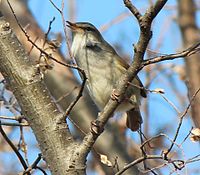Japanese bush warbler
| Japanese bush warbler | |
|---|---|

| |
| Scientific classification | |
| Domain: | Eukaryota |
| Kingdom: | Animalia |
| Phylum: | Chordata |
| Class: | Aves |
| Order: | Passeriformes |
| Family: | Cettiidae |
| Genus: | Horornis |
| Species: | H. diphone
|
| Binomial name | |
| Horornis diphone (Kittlitz, 1830)
| |
| Synonyms | |
|
Cettia diphone | |

The Japanese bush warbler (Horornis diphone), known in Japanese as uguisu (鶯), is an Asian
.Description
The Japanese bush warbler is olive brown above and tending toward dusky colors below. It has pale eyebrows. It has a beak that curves up making it look like it is smiling. The bird is typically 15.5 centimetres (6.1 in) in length.[2]
Distribution and habitat
The Japanese bush warbler is a common year-round resident throughout Japan (except
It was introduced to Oahu between 1929–1941 and has since spread throughout the main Hawaiian Islands.[3]
In summer, it ranges from low hills to high mountains, preferring bamboo thickets and black pine trees. In winter it seeks cover at lower elevations.[2]
Relationship to humans
The propensity of the Japanese bush warbler to sing has led to the birds being kept as cage birds. Robert Young records that to encourage singing the cages of kept birds were covered with a wooden box with a small paper window that allowed only subdued light in.[4] Along with the return of the barn swallow the bush warbler's call is viewed by Japanese as a herald of springtime.
It is one of the favorite motifs of
The beauty of its song led to the English name Japanese Nightingale,
An uguisu-jō (jō = woman) is a female announcer at Japanese baseball games, or a woman employed to advertise products and sales with a microphone outside retail stores. These women are employed because of their beautiful 'warbling' voices. They are also employed to make public announcements for politicians in the lead-up to elections.
In Japanese architecture there is a type of floor known as
The nightingale's droppings contain an enzyme that has been used for a long time as a skin whitening agent and to remove fine wrinkles. It is sometimes sold as "uguisu powder". The droppings are also used to remove stains from kimono.
Songs

- Pi pi pi... kekyo kekyo Hooo- hoke'kyo Hoohokekyo. Young Japanese bush warblers do not initially perform the "hoohokekyo" song skillfully, but gradually learn to sing by imitating others in the vicinity.
- Hooo- hokekyo, hooo- hokekyo. The songs of two Japanese bush warblers are recorded here on a single file.
References
- . Retrieved 12 November 2021.
- ^ ISBN 0-87011-746-7.
- ^ Japanese Bush Warbler Retrieved April 22, 2017
- ^ a b Robert Young. Yedo and Peking. London: John Murray, 1863. viii. 120.
- ^ Frank Reynolds and Jason A. Carbine. The Life of Buddhism. Berkeley: University of California Press, 2000. 32.
- ^ Catarina Blomberg. The West's Encounter with Japanese Civilization: 1800-1940. Tokyo: Japan Library (Curzon Press), 2000. 52.
Hamao, S. and M. Hayama, 2015. Breeding ecology of the Japanese Bush Warbler in the Ogasawara Islands. Ornithological Science, 14: 111–115.
Hamao S (1997) Ippu-tasai no tori: Uguisu (A polygynous bird: the Japanese Bush Warbler). Bun-ichi Sogo Shuppan, Tokyo (in Japanese).
External links
- Japanese bush-warbler, Mike Danzenbaker's bird photo website.

